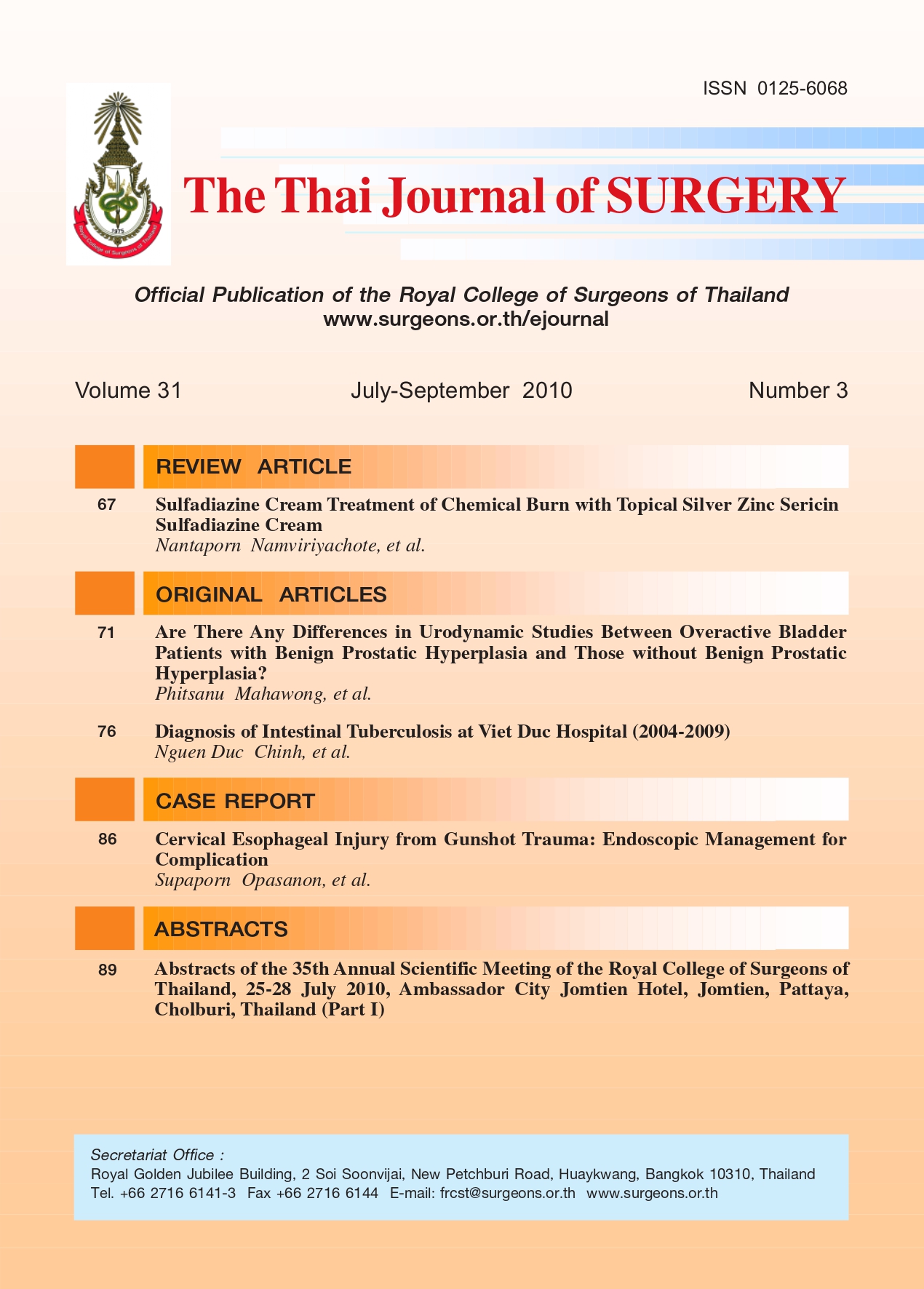Sulfadiazine Cream Treatment of Chemical Burn with Topical Silver Zinc Sericin Sulfadiazine Cream
Abstract
Treatment of Chemical Burn with Topical Silver Zinc Sericin Sulfadiazine Cream
References
wound management decisions. In: Total burn care, 2nd ed.
New York: WB Saunders Co; 2002.
2. Baxter CR. Topical use of 1.0% silver sulfadiazine.
Contemporary burn management. Boston: Little, Brown
and Co; 1971.
3. Bessey PQ. Wound care. In: Total Burn Care, 3rd ed. New
York: WB Saunders Co; 2007.
4. Dash R, et al. Silk sericin protein of tropical tasar silkworm
inhibits UVB-induced apoptosis in human skin keratinocytes.
Mol Cell Biochem 2008;311:111-9.
5. Dash R, Acharya C, Bindu PC and Kundu SC. Antioxidant
potential of silk protein sericin against hydrogen peroxideinduced
oxidative stress in skin fibroblasts. BMB Reports
2008;41:236-41.
6. Aramwit P, et al. Monitoring of inflammatory mediators
induced by silk sericin. J Biosci Bioengineer 2009;107:556-61.
7. Aramwit P and Sangcakul A. The effects of Sericin Cream on
Wound Healing in Rats. Biosci Biotechnol Biochem
2007;71:2473-7.
8. Papini R. ABC of burns: management of burn injuries of
various depths. Br Med J 2004;329:158-60.
9. Stanford W, Rappole BW, Fox Jr CL. Clinical experience with
silver sulfadiazine, a new topical agent for control of
pseumanas infections in burns. J Trauma 1969;9:377-88.
10. Russell AD, Hugo WB. Antimicrobial activity and action of
silver. Prog Med Chem 1994; 31: 351-70.
11. Carr HS, Wlodkowski TJ, Rosenkranz HS. Silver Sulfadiazine: In
vitro antibacterial activity. Antimicrob Agents Chemother
1973;4:585-7.
12. Fuller FW. The Side Effects of Silver Sulfadiazine. J Burn Care
Res 2009;30:464-70.
13. Vincent KM, et al. In vitro cytotoxicity of silver: implication for
clinical wound care. Burns 2004;30:140-7.
14. Fox JR, Rao TN, Azmeth R, Gandhi SS, Modak S. Comparative
evaluation of zinc sulfadiazine aims silver sulfadiazine in burn
wound infection. J Burn Care Rehabil 1990;11:112-7.
15. Agren MS. Studies on zinc in wound healing. Acta Derm
Venereol Suppl (Stockh) 1990;154:1-36.
16. Takasu Y, Yamada H and Tsubouchi K. Isolation of Three
Main Sericin Components from the Cocoon of the Silkworm,
Bombyx mori. Biosci Biotechnol Biochem 2002;66:2715-8.
17. Tokutake S. Isolation of the Smallest Component of Silk
Protein. Biochem J 1980;187:413-7.
18. Kurioka A, Kurioka F,and Yamazaki M. Characterization of
sericin powder prepare from citric acid degraded sericin
polypeptides of the Silkworm Bombyx mori. Biosci Biotechnol
Biochem 2004;68:774-80.
19. Padamwar MN, et al. Silk sericin as a moisturizer: an in vivo
study. J Cosmetic Dermatol 2005;4:250-7.
20. Sobajo C, Behzad F, Yuan XF and Bayat A. Silk: a potential
medium for tissue engineering. Eplasty 2008;8:47.
21. Altman GH, et al. Silk-based biomaterials. Biomaterials
2003;24:401-16.
22. Aramwit P, et al. The effect of sericin with variable aminoacid
content from different silk strains on the production of
collagen and nitric oxide. J Biomater Sci 2009;20:1295-306.
23. Tsubouchi K, Igarashi Y, Takasu Y. Sericin enhances
attachment of cultured human skin fibroblasts. Biosci
Biotechnol Biochem 2005;69:403-5.
24. Zhaorigetui S, et al. Silk protein, sericin, suppresses DMBATPA-
induced mouse skin tumorigenesis by reducing oxidative
stress, inflammatory responses and endogenous tumor
promoter TNF-α. Oncol Rep 2003;10:537-43.
25. Teramoto H, Kameda T and Tamada Y. Preparation of gel
film from Bombyx mori silk sericin and its characterization as
a wound dressing. Biosci Biotechnol Biochem 2008;72:3189-
96.
26. Nagai N, et al. Enhancing effects of sericin on corneal
wound healing in Otsuka Long-Evans Tokushima fatty rats as
a model of human type 2 diabetes. Biol Pharm Bull
2009;32:1594-9.
Downloads
Published
How to Cite
Issue
Section
License
Articles must be contributed solely to The Thai Journal of Surgery and when published become the property of the Royal College of Surgeons of Thailand. The Royal College of Surgeons of Thailand reserves copyright on all published materials and such materials may not be reproduced in any form without the written permission.


